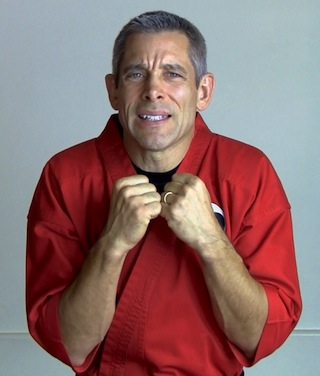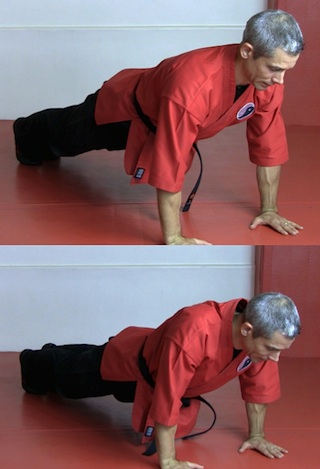Worried about shoulder flexibility and strength? If you’re a martial artist, you should be!
In the course of training, you’re going to throw thousands of punches. If you’re doing thousands of push-ups, bench presses, and shoulder presses on top of that, you’re at risk of overtraining your shoulders.
That’s what happened to me!
In this video, I’m going to show you one simple exercise to develop your shoulder flexibility, plus one tweak to your technique to help increase strength and make your fighting movements more effective.
If this video doesn’t play, you can find a summary below.
My sad story…
In my mid-30’s, after years of martial arts training, I started having issues with my shoulders. They were aching all the time, my range of motion was getting tighter and tighter, and eventually I suffered a labral tear.
When the doctor examined my injury, he pointed out that while my chest and front deltoid were well developed, my back muscles, lats, and rear deltoid were under-developed.
Why?

Because I had spent most of my training time pushing and punching, not grabbing, pulling, and holding. All those years of rounding my shoulders forward and curling up in a fighting stance had resulted in frozen, inflexible shoulders.
The rehab for my shoulder was simple—I needed to start pulling as much as I pushed.
In the gym, that meant exercises like seated rows, dumbbell rows, pull ups, and reverse butterflies.
On the mats, it meant paying as much attention to my hikite or pulling hand—the traditional fist on the hip—as I did to my extending hand.
After a couple of months of pushing and pulling, guess what happened?
The pain went away and my flexibility came back. But that wasn’t the best part! The best part was all of my fighting techniques got better!
Throws, takedowns, sweeps, lock ups—I was grabbing and controlling people better than ever. Even though I had always used my pulling hand, it turns out I wasn’t using it very well!
So, based on my mistakes, here are three tips to help save your shoulder from overtraining and kick your fighting up a notch.
Tips for Shoulder Flexibility and Strength in Martial Arts
DISCLAIMER:
I am not a personal trainer or physical therapist. I’m just a martial artist sharing his experience. Proceed and practice at your own risk!
TIP #1: Make rest time part of your training time.
If you burn out your arms throwing punches on the heavy bag today, then hit the weights and max out your bench press tomorrow, you might be overtraining. Maybe you can get away with that in your 20’s, but as you get older, it’s not so easy for your body to keep up.
I’m not saying don’t lift weights, but ask yourself—is your goal to be a great martial artist or a great bodybuilder? You really can’t be both.
Sure, some martial artists are blessed with the genetics of a superhero. And sure, some pro fighters are built like gods…
But unless you’re a professional, full-time athlete working out six to eight hours a day under the watchful eye of trainers and nutritionists, you’re better off making a choice.
For me, one look at my skinny neck and you’ll know I’ve decided to make martial arts my first priority and only supplement my training with weights.
How about you?
Whatever you decide, prioritize your goals, listen to your body, and give yourself a chance to rest and recover.
TIP #2: Pay attention to your whole shoulder.
By “whole shoulder”, I mean all three “heads” of your deltoid muscle: anterior, lateral, and posterior.
Here’s a simple exercise that built up my shoulder awareness and broke the ice on my frozen, rounded posture.

Start off in a plank or push up position…
Now do a push up without using your arms!
That’s right—raise and lower your body using only your shoulders. Don’t bend your elbows at all. Just relax and feel the front of your shoulder stretch, then squeeze your chest and round it out.
Isolating the shoulder like this might feel a little strange at first. Good! It’s working!
To be clear, you shouldn’t be trying to build up speed or power with this movement, just awareness.
A quick set of these before you hit the mats or hit the weights will get your shoulder on the right track.
TIP #3: Pull with your back, not just your arms.
At the gym, you’ll see a lot of guys performing rows and pull ups using their arm muscles instead of engaging their back muscles by squeezing their shoulder blades together.
Weightlifting tip:
When you’re reaching or extending your arms, stretch your lats. When you’re pulling in, pinch your scapulas together.
You see the same mistake being made in Karate and Kung Fu. Lots of students pull back their arm without engaging their back muscles when practicing traditional push/pull movements. It’s easy to understand why…
First, it’s smart to stay in a defensive shell. You don’t want to pull back and open yourself up to attack.
Second, our eyes are in the front of our head. That means we can see the hand going out, but not the hand coming back. Out of sight, out of mind.
Third, smacking someone in the head is proof we’re winning, so that’s where we put our focus.
All of that adds up to trouble! Boxing is cool, but as martial artists, we should also be grabbing, pulling, and holding. That’s our secret sauce.
So, make this tweak to your technique…
When you practice your hikite, pull with your back, not just your arm.
Instead of keeping your shoulder rolled forward, find a groove for your elbow so it can slide over your ribs and connect to the power of those big back muscles.
Of course, that’s just my personal recommendation. If you feel pulling with your back doesn’t fit your particular style, do whatever you want. But I would still tell you this—
If you think about pulling with your back as much as pushing with your chest, you will open up a whole new dimension in your fighting.
Which brings us to the big message— balance. Yin and yang.
Don’t get so caught up doing one thing that you completely ignore something else.
Hard is vulnerable to soft. Soft is vulnerable to hard.
Be smart…
If you push, pull. If you do crunches for your stomach, arch your back. If you train hard, rest hard.
The secret to staying happy and healthy is seeking balance in your strategy, your attitude, and your body.
That’s not just good advice for shoulder flexibility, it’s good advice for life!
